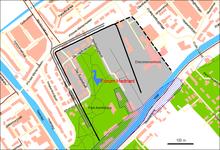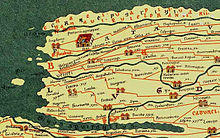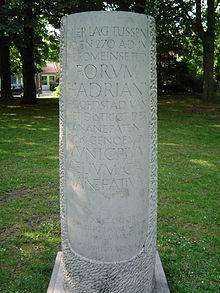Forum Hadriani, in the modern town of Voorburg, was the northernmost Roman city on the European continent and the second oldest city of the Netherlands.[1] It was located in the Roman province Germania Inferior and is mentioned on the Tabula Peutingeriana, a Roman road map.
The site Forum Hadriani formed the nucleus of the civitas of the Cananefates, who lived west of the Batavians. It was situated along the Fossa Corbulonis or Corbulo-canal. This waterway was established about 47 AD by the Roman general Gnaeus Domitius Corbulo, forming an important shortcut between the rivers Rhine and Meuse. After the Batavian Rebellion, in which they participated, the Cananefates became loyal allies of the Romans.
In 121 emperor Hadrian made a long voyage along the northwestern border of the empire, during which he visited the Cananefate town. He gave the town his own name, Forum Hadriani (Hadrian’s Market). An alternate name, maybe the only official name, was Municipium Aelium Cananefatium (Aelius being the family name of Hadrian). The shortened version of this name, MAC, has been found engraved in a couple of Roman milestones found in the neighbourhood.
About 270 AD, after several plagues and attacks by Saxon pirates, the Romans abandoned Forum Hadriani.
In 1771 a bronze right hand was excavated during garden work on the Arentsburg estate. This hand was used by Étienne Maurice Falconet as model for the equestrian statue of Peter the Great, The Bronze Horseman. The first scientific excavations at the site of Forum Hadriani were carried out by Caspar Reuvens, between 1827 and 1833. Reuvens held the world's first professorship of archaeology. Reuvens died before he could publish his findings. More excavations were done between 1908 and 1915 by Jan Hendrik Holwerda, who published the results of Reuvens together with his own discoveries in a comprehensive monograph in 1923.
See also
References
- ^ W. de Jonge, J. Bazelmans and D.H. de Jager (eds), Forum Hadriani. Van Romeinse stad tot monument. Utrecht, 2006
External links




.jpg)